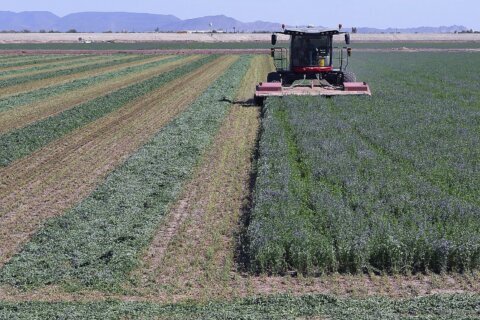CHICO, Calif. (AP) — Firefighters made progress Saturday against California’s largest wildfire of the year ahead of expected thunderstorms that could unleash fire-starting lightning and erratic winds and erode progress made over the past week. Dry, hot conditions posed similar threats across the fire-stricken West.
“We’re not completely out of the woods yet, but we’re looking very, very good,” CalFire official Mark Brunton said in a video update Saturday. “This is moving at a very fast pace.”
Containment of the Park Fire, now California’s fourth-largest wildfire on record, was at 27% as of Saturday afternoon. Brunton said the relatively milder weather the last few days allowed firefighters to build containment lines.
But hotter weather, fuels and terrain will continue posing challenges for the estimated 6,500 firefighters battling the fire, which has spread over 626 square miles (1,621 square kilometers) since allegedly being started by arson in a park in the Sierra Nevada foothills east of the Sacramento Valley city of Chico. For comparison, the city of Los Angeles covers about 503 square miles (1,302 square kilometers).
Suppression crews will also start removing damaged infrastructure in some areas Saturday. People living in the rural communities of Cohasset and Forest Ranch were told they could start returning home Saturday afternoon.
The fire originated at low elevations, where it quickly burned through thick grass and oaks, destroying at least 567 structures and damaging 51 so far. As it has climbed higher, the vegetation has changed to a greater concentration of trees and brush, Cal Fire said.
The fire’s push northward has brought it toward the rugged lava rock landscape surrounding Lassen Volcanic National Park, which has been closed because of the threat. The area remains one of the biggest challenges for firefighters, Cal Fire officials said Saturday afternoon. The smoke has also prevented firefighters from deploying helicopters and other aircrafts the last few days.
“There’s a lot of really steep drainages in that area,” CalFire spokesperson Devin Terrill said. “It takes a lot more time to access those areas.”
After a brief respite, firefighters are now bracing for treacherous conditions of hot and dry weather, along with expected thunderstorms with potential thunder strikes and gusty winds.
The collapse of thunderstorm clouds can blow wind in any and all directions, said Jonathan Pangburn, a fire behavior analyst with Cal Fire. “Even if there’s not lightning per se, it is very much a safety-watch-out environment for our firefighters out there,” Pangburn said.
The Park Fire is among almost 90 large fires burning across the western U.S. Evacuation orders were in effect for 22 of the fires, according to the National Interagency Fire Center.
Crews made progress Saturday against three major fires burning in Colorado near heavily populated areas north and south of Denver, with containment figures improving and some evacuation orders lifted. One of the fires was being investigated as arson. About 50 structures had been damaged or destroyed, about half of them homes, and one person was found dead in a burned home earlier in the week.
The Jefferson County Sheriff’s Office is investigating a blaze threatening hundreds of homes near the Colorado city of Littleton as arson.
Karlyn Tilley, a spokesperson for Jefferson County Sheriff’s Office, said the investigation is ongoing, and investigators are using a dog specially trained to sniff out sources and causes of fires. Tilley said just because they suspect the fire was human-caused doesn’t mean it was intentional.
Firefighters were making good progress on the fire despite the steep, rocky terrain and blistering heat, and no houses had been burned, officials said.
The cause and origin of a fatal blaze west of the town of Lyons was being probed by the federal Bureau of Alcohol, Tobacco, Firearms and Explosives, with specially trained fire investigators from the agency helping local authorities, agency spokesperson Crystal McCoy said. The area blackened by that fire remained relatively unchanged after it burned five houses.
The largest of the Colorado fires, west of Loveland, grew to 14.9 square miles (38.5 square kilometers) after previously burning 49 homes and other structures. Its cause is under investigation.
Scientists say extreme wildfires are becoming more common and destructive in the U.S. West and other parts of the world as climate change warms the planet and droughts become more severe.
Copyright © 2024 The Associated Press. All rights reserved. This material may not be published, broadcast, written or redistributed.







